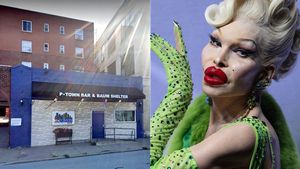Released on the brink of a looming decade marked by intense homophobia, executions for sharing atomic bomb secrets, and the threat of "reds under the bed," Strangers on a Train played with the fear of homosexuality in American public life. This was a project Alfred Hitchcock later honoured -- perhaps even elevated -- a year later in his iconic film adaption of Highsmith's book.
In Strangers, the lives of two ordinary men, Guy and Bruno, are inextricably bound by a chance encounter on a train. First, the two exchange words; next they exchange murders. Bruno is to murder Guy's ex-wife, who has been unfaithful and is unwilling to divorce Guy so that he may marry his new lover Anne. As a trade-off, Guy is to kill Bruno's overbearing and tyrannical father in order for this patriarch's oppressive regime can be stopped and an Oedipal fantasy can be fully realised.
The novel was a dime-store potboiler, with a rich homoerotic tension that simmered below the story of the traded murders. While Hitchcock's adaptation differed significantly -- brutally killing the effeminate, queer Bruno under a merry-go-round, the symbol of circularity and fate -- Highsmith's Strangers on a Train was far more interested in playing with Guy's potential homosexuality, blurring those denominators of the Kinsey scale.
But it was in 1952, when Highsmith published The Price of Salt, that Highsmith cemented her place in the history of queer literature of America. This slim novel, originally released under the pseudonym Claire Morgan, told the story of a department store clerk who began a forbidden sexual affair with a married housewife named Carol. Although it drew some press when it was first released, it was only its mass-paperback edition a year later that it really proved popular. It sold nearly a million copies.
But the book soon went out of print and Highsmith didn't acknowledge it as her own until, decades later, when it was reprinted five years before her death. Retitled Carol, Highsmith wrote an afterword for the book, in which she explained shey she originally decided to publish the book nder a nom de plume--because she didn't want readers to associate her with paperback novels and homosexual themes, but also because she didn't want readers of Carol to read between the lines and infer that the source-material for the book was more autobiographical than fictional. Now that Todd Haynes has directed an adaptation of the book, starring Cate Blanchett in the title role and Rooney Mara in the character based on herself, the wider world will come to understand more than Highsmith ever imagined possible.
Highsmith's afterward to Carol locates the book in the darker days of homosexuality in America's history. She writes that during this decade people would take a train and stop a station before their designated stop to frequent a gay bar, "lest they be suspected of being homosexual." Raids were common, and the stakes of being caught in a gay bar were high.
In spite of the intense homophobia of the decade, Carol became an enormous success for Highsmith, earning a passionate and indeed confessional audience. Thousands of readers wrote to Highsmith -- care of Claire Morgan -- thanking her for writing such a book, one of the few of the time that offered readers a "happy ending." Carol was, and for many years after, one of the few popular gay novel that did not have its two characters kill themselves, abandon each other at a train station, or find themselves shot dead in the back of a Mexican bar, like so many others did at the time.
So important was Carol that it resisted many of the antecedents of the queer canon of American fiction. Novels of the previous decade had painted queers (mostly gay men) in a negative light, showing them as mentally unsound, suicidal or homicidal, and completely displaced and often on the fringes of the society at large. One only has to look at Hitchcock's adaptation of Strangers for evidence of this culture, where the queer Bruno is portrayed as conniving, manipulative, and obsessed (not to mention homicidal).
Carol stood out from other novels of the era because it gave readers a "happy ending," showing that same-sex relationships would not always be an impossibility in American society. The book gave readers hope.
Other infamous "gay novels" of the time, including Gore Vidal's 1948 novel The City and the Pillar, or Marijane Meaker's pulpy dime store Spring Fire (published the same year as Carol and similarly under a pen name), showed gay and lesbian relationships in a markedly different light.
Vidal ended his novel with the gay protagonist Jim murdering his former lover. (In the revised edition of The City and the Pillar, the roles are changed and Jim is brutally raped by the same man).
Meaker's pulpy Spring Fire was about a college sexual relationship between a freshman and sorority sister (who is mentally unstable, we later learn). The book ended with the sorority sister entering a mental institution and the young freshman discovering that she never really loved her older female peer. Meaker later explained in a postscript to the book that her male editor insisted on this ending, since homosexuality could not be portrayed in favourable terms. (Meaker and Highsmith later become lovers.)
While Highsmith feared being labelled a "lesbian writer," her other books continued to engage in homoerotic themes, including the iconic The Talented Mr. Ripley (1955). The thriller saw Highsmith return to her earlier roots of intrigue and murder of Strangers infamy, offering readers a gripping tale of Tom Ripley, whose obsession with another man was not dissimilar to many other characters other writers etched of gay men at the time.
By mining the archive of Highsmith's back-catalog we can glean a more significant contribution to American queer literature. Because many of her books were paperback thrillers, and not of the more high order other gay male writers achieved like Vidal, Truman Capote, or Tennessee Williams, her place in the American canon is often overlooked.
But from this small shelf of titles from a different time and place in American history, Highsmith's Carol still stands out as one of the most important. Although it may not be the most discussed or written about as much as Vidal or Meaker has, its "happy ending" remains a watershed moment in the history of gay literature.
We can only hope that Haynes's forthcoming adaptation of Carol continues to encourage readers to appreciate the legacy of Highsmith and valorise its importance in America's closeted literary history.




















































